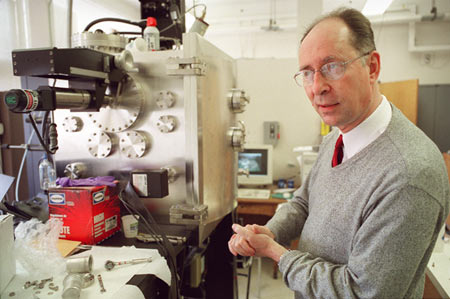Rowland Institute merges with Harvard

Harvard and the Rowland Institute for Science, an interdisciplinary research institute in Cambridge, have negotiated a merger agreement, to become effective later this spring. This merger aims to both strengthen and enrich the Rowland’s intellectual and physical resources, building on a longstanding collaborative relationship with Harvard, and to enable Harvard to develop its research and teaching opportunities, drawing upon the unique resources of the institute.
Phil DuBois ’53, president of the Rowland Institute, said, “We have the resources, financial and technical, which enable us to react to, and quickly support, cutting-edge science. Harvard brings long-term stability and wonderful opportunities for teaching, mentoring, and expanded intellectual connections and collaborations.”
“I am excited by the opportunities that this merger presents to us,” commented Jeremy R. Knowles, dean of the Faculty of Arts and Sciences. “We shall be able nimbly to support cross-disciplinary research, to encourage interactive scientists early in their careers, and to integrate faculty colleagues, graduate students, and undergraduates into the work that goes on there.”
Founded in 1981 as the “last experiment” of the accomplished scientist and entrepreneur Edwin H. Land, the Rowland Institute has developed a distinguished reputation for multi- and interdisciplinary research, especially in evolving areas at the junction of traditional fields such as physics and biology. The merger with Harvard will preserve Land’s original vision of an intensely collaborative, collegial institute, with an emphasis on experimental rather than theoretical science, and a focus on “small science” groups of two to four scientists working together on challenging projects of relatively limited duration.
Under the direction of Frans Spaepen, Gordon McKay Professor of Applied Physics at Harvard, the re-named Rowland Institute at Harvard will, among other things, initiate a Rowland Fellowship program, enabling postdoctoral scientists at the early stages of their careers to pursue high-risk work in an environment of maximal creativity. Spaepen anticipates that the first cohort of Rowland Fellows will be selected by fall 2003.
The Institute staff currently consists of a group of Rowland Senior Fellows who were members of the original Rowland research staff. These Senior Fellows are engaged in multidisiplinary research projects in nanoscience and technology and biophysics. In addition to continuing their own research, the Rowland Senior Fellows will serve as mentors for the incoming group of Junior Fellows.
Intellectual life at the institute will also be fed by Harvard undergraduate and graduate students, brought into research partnerships with faculty and senior scientists engaged in cutting-edge work.
Located on the banks of the Charles River, at 100 Edwin H. Land Blvd., the 110,000-square-foot institute will operate under the auspices of the Faculty of Arts and Sciences. The institute is intended to serve as an incubator for some of the most promising scientists of the future. Both Harvard and Rowland officials hope for an aggressive upswing in scientific activity over the next few years.
Spaepen said of the merger, “It’s an extraordinary opportunity to do something for experimental science. With the resources that the Rowland has, and the possibility of bringing in bright young people, this is something completely new not only for Harvard but for the scientific community in general.”
Spaepen, who received his Ph.D. in applied physics from Harvard in 1975, joined the Harvard faculty in 1977. He moved from assistant professor to associate professor in 1981, and became a full professor in 1983. From 1990 to 1998, Spaepen served as director of the Harvard Materials Research Science and Engineering Center, which fosters cross-disciplinary work among faculty from the Division of Engineering and Applied Science (DEAS), the departments of physics, chemistry and chemical biology, molecular and cellular biology, and the Harvard Medical School.
According to Venkatesh Narayanamurti, dean of DEAS, Spaepen “has outstanding experience in working across disciplines. Rowland will be in very good hands with him at the helm.”
Spaepen’s own research, which ranges across theoretical and experimental topics in materials science, often operates at the boundaries. His work has dealt with amorphous metals and semiconductors, the structure and thermodynamics of interfaces (crystal/melt, amorphous/crystalline semiconductors, grain boundaries), the mechanical properties of thin films, and the perfection of silicon crystals for metrological applications.
“We are delighted that Frans Spaepen has been chosen to be the director,” said DuBois. “As a member of the division he has been part of a Harvard department whose culture of interdisciplinary research is closer to that of Rowland than many others. He has personal traits of openness, thoughtfulness, and kindness, and an appreciation of the special qualities of the institute that make him ideal.”
Harvard’s ties with the Rowland run as far back as Land’s own attendance at Harvard College in the 1920s, and his honorary doctorate in 1957. Over the past 20 years, current Harvard faculty such as physicist Lene Hau, physicist Jene Golovchenko, biologist Markus Meister, and biophysicist Howard Berg have participated in the Rowland community, working on projects ranging from manipulating the speed of light, to using ion beams to sculpt microscopic holes that help read DNA, to measuring the retina’s response to motion, to understanding the motility of bacteria.
Land, founder of Polaroid Corp. and inventor of the instant camera, whose innovations in camera technology and the field of polarized light have had widespread applications in scientific and medical research, once said: “Discoveries are made by some individual who has freed himself from a way of thinking that is held by friends and associates who may be more intelligent, better educated, better disciplined, but who have not mastered the art of the fresh, clean look at the old, old knowledge.”
The Rowland Institute at Harvard, it is hoped, will provide a fresh, clean look.




